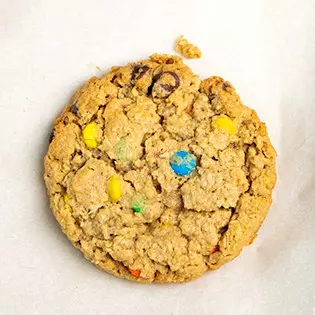

This simple and customizable recipe for gluten free monster cookies is packed with peanut butter, oats, and chocolate. Plus, they're made without any rice flour or flour blend at all.
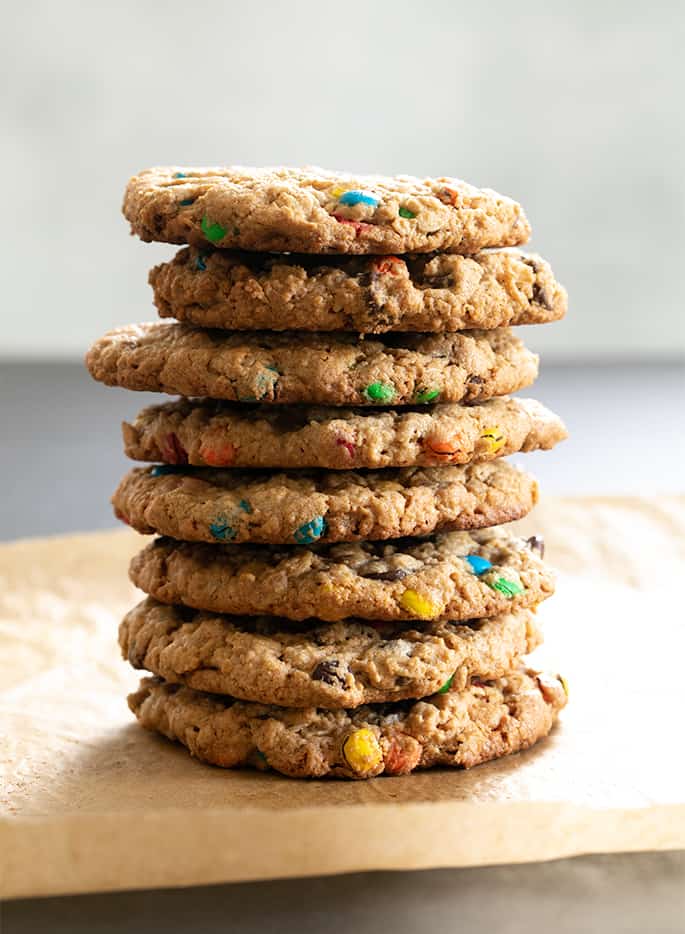
What are monster cookies?
Monster cookies are basically just peanut butter cookies or oatmeal cookies with M&M chocolate candies and chocolate chips mixed in. They're called “monster cookies” since they're like the Frankenstein's monster of cookies. All due respect to monsters. And cookies.
Are monster cookies gluten free?
Most monster cookie recipes have some all purpose flour added, along with oats, to help give them structure. It's just like what you would do with traditional (gluten free) oatmeal cookies.
The best thing about baking cookies with oats and oat flour in them is that they have a really satisfying chew to them. That's why our “Mrs. Fields” gluten free chocolate chip cookies have oats—and probably why they're the most popular chocolate chip recipe on this site.
And that makes this recipe for monster cookies naturally gluten free, unlike almost every other recipe for monster cookies you'll find—gluten free or not.
Why you'll love these monster cookies
The hearty, chewy texture, derived from the clever use of old-fashioned rolled oats and oat flour, creates a satisfying and filling cookie. Their versatility allows you to adapt the recipe to suit your preferences or cater to other dietary restrictions easily.
The simple preparation method minimizes cleanup and makes the baking them really easy. The base is very similar to a classic gf oatmeal cookie, but since there's no all purpose flour at all and only whole grains, it's heartier and has more of the nutty, chewy flavor of oats.
The cookie is bound together with an egg, an egg yolk, and peanut butter. Along with old fashioned rolled oats and oat flour, the combination creates a chewy cookie that's really stable (great for shipping in a care package!) and crispy on the outside.
The candy shell on the miniature chocolate M&Ms candies in these peanut butter oatmeal M&M cookies adds even more texture to these sweet chocolate chip cookies.
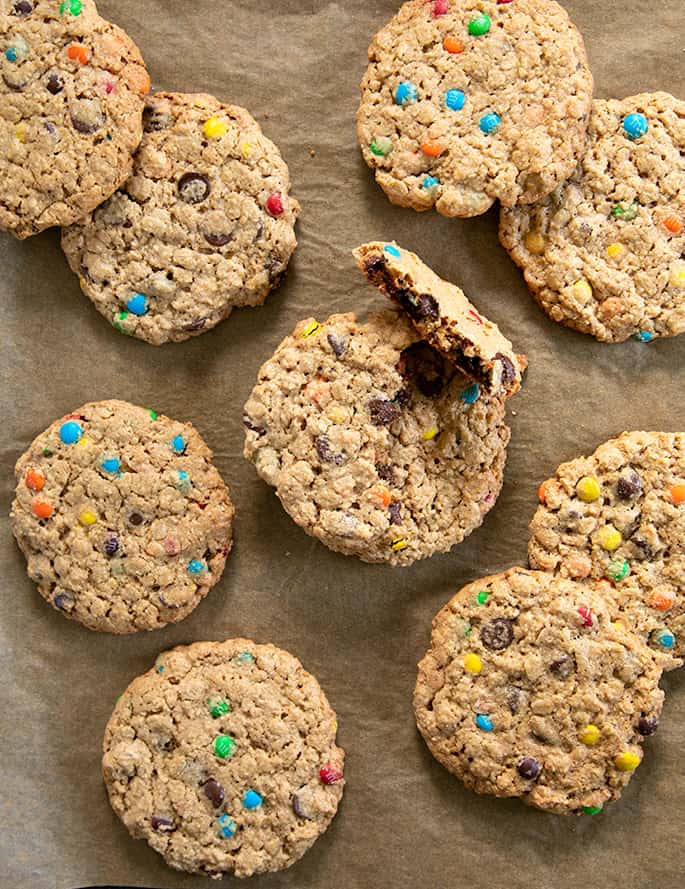
(All Purpose) Flourless Monster Cookies
I take flourless baking very seriously. Well, I mean not “seriously” like you would health or welfare, but I don't use the term “flourless” lightly, is all.
When any grain or even nut is ground into a flour and used in the recipe, I don't consider it truly flourless. But this recipe is rice flourless/all purpose flourless. All of my all purpose gluten free flour recipes are based on rice flour.
Key ingredients in GF monster cookies
- Old-fashioned rolled oats – Since these are gluten free monster cookies, we need to use so-called purity protocol gluten free old-fashioned rolled oats; they're thin enough to chew, unlike steel cut oats, which must be soaked to eat
- Oat flour – I never buy gluten free oat flour; I just grind some of my old fashioned oats into oat flour in a blender; here, they help hold the cookie together without using a rice flour blend.
- Butter – Your butter should be at “room temperature,” which means that you can leave a fingerprint in it, but your finger doesn't come away greasy
- Peanut butter – I love baking with no-stir smooth peanut butter, since it combines so well with other ingredients, much like room temperature butter does.
- Eggs – We use 1 whole egg for lift and as a binder, and 1 egg yolk, which helps soften the cookies' texture (peanut butter tends to make baked goods crunchy)
- Light brown sugar – Light brown sugar has more moisture from the added molasses than granulated sugar; it tenderizes cookies and adds depth of flavor
- Chocolate chips and M&Ms – Some people make monster cookies with regular size M&Ms, but I really prefer semi-sweet chocolate chips, and miniature M&Ms for added texture and flavor.
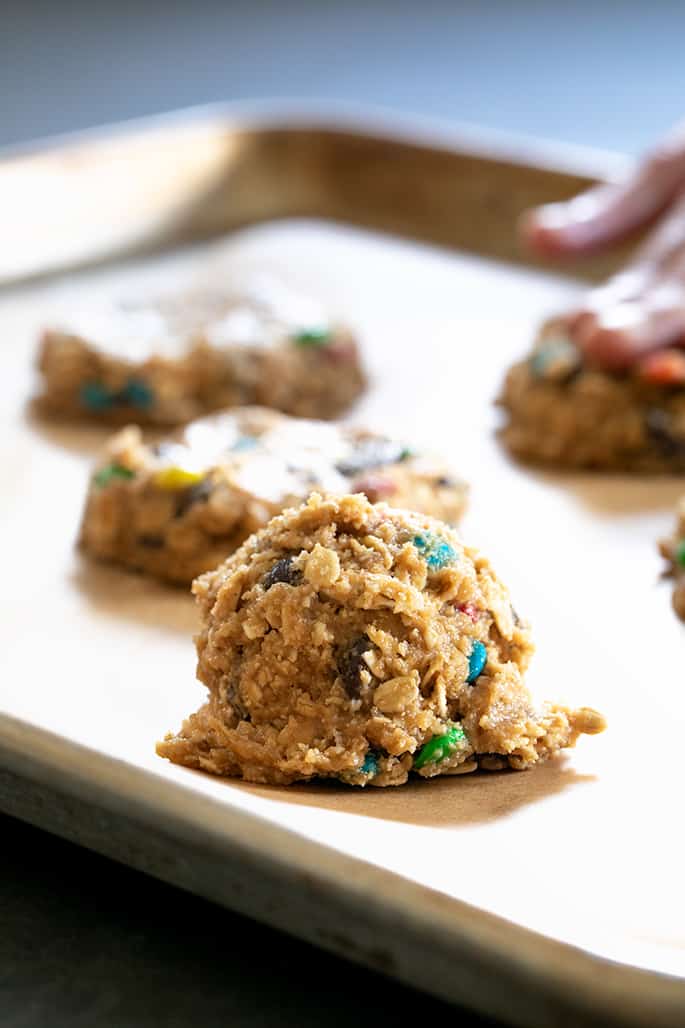
Baking gluten free monster cookies with oats and oat flour
Baking with oats (which substitute for oats, if you're unable or unwilling to eat them!) can be tricky. Old fashioned rolled oats, which are one of the least processed forms of oats, are relatively thick.
One way to make a stable cookie that holds together is to add a rice flour blend to it. But in this gluten free chocolate chip monster cookies recipe, I simply ground some old fashioned rolled oats into a flour and added that to the recipe. Oats are simple to grind into a flour in a blender or food processor.
The rest of the oats in this recipe are more like quick-cooking oats. Rather than buying gf quick oats, I just pulse old-fashioned oats a few times in a food processor.
How to make these gluten free monster cookies cookies
Whenever possible, I try to make cake batter and cookie dough in one single bowl. I find that it's not often necessary to beat butter, sugar, and eggs separately unless you're making a delicate vanilla cake, for example.
- First, mix the dry ingredients (oat flour, oats, baking soda and salt) in a separate bowl.
- Mix the butter, peanut butter, eggs, vanilla and brown sugar separately. This makes it easier to get the lumps out of the brown sugar.
- Add the dry ingredients mixtureto the wet ingredients and mix just to combine.
- To make this recipe in one bowl, whisk together the dry ingredients in a large bowl, create a well in the center of the dry ingredients and add the wet ingredients (butter, peanut butter, egg mixture, vanilla, and sugar).
- Mix the cookie dough until just combined.
- Add the chips and candies, and mix again gently to combine.
- Scoop the dough into large mounds, and press them gently into disks on a lined baking sheet.
- Bake at 350°F/177°C for about 14 minutes.
- Allow the cookies to set on the baking sheet for a few minutes before moving them, or they'll fall apart. After cooling, the cookies are very stable.
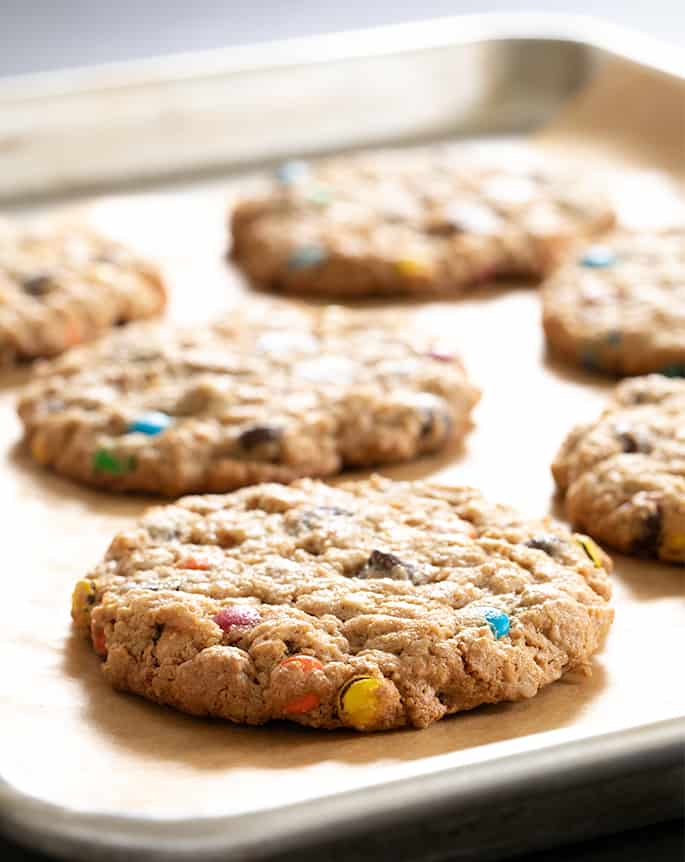
Tips for making the best gluten free monster cookies
This recipe is so easy, it's difficult to get wrong. But, there are a few quick tips that ensure your gluten free monster cookies are the best they can be.
Use an ice cream scoop for easy portioning
Right after the dough is assembled, scoop large rounded balls of dough using a spring-loaded ice cream scoop that's packed tight to help create a round shape. If you have trouble getting the cookie dough out of the scooper, rinse it with warm water in between scoops.
Use no-stir peanut butter for better results
Truly all natural peanut butter that requires stirring is usually too oily for baking, and tends to separate in the cookie dough. No-stir peanut butter has emulsifiers that keep the oil mixed in to the nut butter.
Use parchment paper for quick cleanup
Line your baking sheets and pans with parchment paper to ensure even baking, and to make cleanup a breeze. I keep and reuse sheets of parchment multiple times, to avoid so much waste.
Don't mix too much
When baking with oat flour especially, the baked goods can become tough if you work the batter or dough too hard. This way, the oats can be handled much less when everything is combined.
Making gluten free monster cookie dough in advance
You can make this gluten free monster cookie dough ahead of time, as long as you shape the balls of cookie dough right after you make the mixture. As the cookie dough sits, the oils get more fully absorbed into the flours, and the dough may not hold together as well. Just shape the cookie dough balls, then cover the portions and you can bake it hours later.
Refrigerating gluten free monster cookies dough
If you'd like to make the monster cookie dough farther in advance, you can refrigerate the shaped portions for 2 to 3 days. Be sure to cover them first so they don't dry out, and allow the cookie dough to come to room temperature before baking.
Freezing gluten free monster cookies dough
For longer storage, try flash freezing the dough balls on a baking sheet in a single layer. Transfer them to a zip-top bag for longer storage. To ensure that the cookies spread properly, let them come to room temperature before baking.
How to store monster cookies
Monster cookies are really stable and stay fresh for days in a sealed glass container at room temperature. Don't store them in a plastic container at room temperature, or they'll lose their crisp exterior and become more fragile.
Freezing baked monster cookies
You can freeze these baked monster cookies in a freezer safe zip-top bag and enjoy them right from the freezer, or warmed up a bit in the microwave or on the counter. Squeeze as much air as possible out of the bag to avoid freezer burn.

Substitutions for gluten free monster cookies ingredients
These crisp-outside, chewy inside cookies have a fair number of additional allergens in them. Here are my best guesses for how to avoid them.
Please keep in mind that this recipe was formulated to work precisely as written. The more substitutions you make, the more you are veering toward a separate recipe entirely.
Gluten free dairy-free monster cookies
The only dairy in these cookies is from the unsalted butter and the M&Ms chocolate candies. The M&Ms can easily be replaced with more chocolate chips, and you can of course use dairy-free semi-sweet chocolate chips.
I haven't tried replacing the butter, but you should be able to use Melt or Miyoko's Kitchen brand vegan butter. I don't generally like Earth Balance buttery sticks because they have so much moisture which will likely cause the cookies to spread too much during baking.
You can also try replacing the butter with virgin coconut oil. It's the type that's solid at cool room temperature.
Gluten free egg-free monster cookies
The single whole egg in this recipe should be able to be replaced with 1 “chia egg” (1 tablespoon ground white chia seeds + 1 tablespoon lukewarm water, mixed and allowed to gel).
The egg yolk is in the recipe for moisture, so you can try replacing it with about a tablespoon or so of smooth applesauce. I'm afraid you'll just have to experiment!
Monster cookies without peanut butter
If you need to make this recipe without peanuts, I'm sure a similar style of almond butter (like Barney Butter) would work great. I also have a recipe for Nutella monster cookies that is peanut-free.
If you need the recipe to be nut-free, you can try replacing the nut butter with Wowbutter, made with toasted soy nuts, which seems nice and creamy. You could also try sunflower seed butter, but your cookies may spread more, and they may even turn a harmless green color when mixed with baking soda.
Monster cookies without oatmeal
In baking, oat flour can often be replaced with quinoa flakes, and old-fashioned oats can be replaced with beaten rice or sometimes coconut flakes/chips.
More delicious mix-ins for gf monster cookies
- For even more peanut flavor, try replacing some of the mix-ins with chopped roasted peanuts or other chopped nuts.
- Swap in white chocolate chips instead of some or all of the semi-sweet chocolate chips.
- Add crushed mini gluten free pretzel twists or sticks instead of some of the chocolate chips or mini M&Ms

FAQs
If monster cookies are made with conventional all purpose flour, they will contain wheat. This recipe is made without all purpose flour of any kind, and with gluten free oats and oat flour, so it's completely gluten free.
I specify “no-stir”, regular creamy peanut butter in this recipe, as I do in most recipes that I write that contain peanut butter as an ingredient. All “no-stir” means is that the oil in the jar of peanut butter doesn’t separate significantly from the rest of the nut butter in the jar.
Most commercially prepared peanut butter is no-stir. My favorite brand is Skippy, since it's great-tasting, always smooth, and all varieties of Skippy are gluten free. but I also sometimes use Barney Butter—although it tends to be quite expensive. Even Skippy “Natural” peanut butter says on the outside that there's “no need to stir.”
Chunky peanut butter doesn't mix in quite as well as smooth peanut butter in this recipe, so I'd avoid using it in this recipe. Stick with the creamy smooth peanut butter, and replace some of the chips or mini M&Ms with some chopped peanuts for a nutty crunch if you'd like that.
If your butter was melted or oily because it was too warm, your cookies may spread too much and come out flat.
If you live in the U.S., most plain varieties of M&Ms chocolate candies are gluten free. I do understand that if you're in Australia, M&Ms aren't gluten free. Just use miniature chocolate chips or even raisins.
No, these cookies can't be made with almond flour, since it has very different qualities from oats and oat flour.
How to make gluten free monster cookies, step by step (below)
Gluten Free Monster Cookies
Ingredients
- 1 cup (120 g) oat flour (certified gluten free if necessary) (See Recipe Notes)
- 1 ½ cups (150 g) old-fashioned rolled oats, processed slightly (certified gluten free if necessary) (See Recipe Notes)
- ¾ teaspoon baking soda
- ¼ teaspoon kosher salt
- 4 tablespoons (56 g) unsalted butter at room temperature
- ½ cup (128 g) smooth, no-stir peanut butter
- 1 (50 g (weighed out of shell)) egg beaten, at room temperature
- 1 (25 g) egg yolk at room temperature
- 1 teaspoon pure vanilla extract
- 1 cup (218 g) packed light brown sugar
- 5 ounces semi-sweet chocolate chips
- 5 ounces miniature M&Ms chocolate candies (gluten free in the U.S.)
Instructions
- Preheat your oven to 350°F. Line a rimmed baking sheet with unbleached parchment paper and set it aside.
- In a medium-size bowl, place the oat flour, oats, baking soda, and salt, and whisk to combine. Set the bowl aside.
- In a large bowl, place the butter, peanut butter, egg and egg yolk, vanilla, and brown sugar, and mix well. Add the oat flour mixture to the large bowl, and mix until just combined.
- Add the chocolate chips and M&Ms candies and mix until the pieces are evenly distributed throughout the dough. The dough will be thick but should not be stiff.
- Using a spring-loaded ice cream scoop or two spoons and scoop the dough into mounds about 2 1/2 tablespoons each onto the prepared baking sheet, about 2 inches apart from one another.
- Using wet fingers, press each mound down into a disk about 1/2-inch thick.
- Place the baking sheet in the preheated oven and bake for 12 to 14 minutes, or until the cookies are lightly brown around the edges, set in the center and the top of each cookie has taken on a crackled appearance.
- Allow the cookies to sit on the baking sheet for 10 minutes or until set. Serve slightly warm or at room temperature.
- These cookies also freeze amazingly well in a sealed freezer-safe container.
Notes
I never buy oat flour or even quick-cooking oats. I just process old-fashioned rolled oats in a food processor or blender either a little (quick-cooking oats) or a lot (oat flour). Originally published on the blog in 2018. Adapted in 2022: recipe unchanged, some photos new, new resources added to text. More text resources added in 2023.
Gluten Free Monster Cookies
Ingredients
- 1 cup (120 g) oat flour (certified gluten free if necessary) (See Recipe Notes)
- 1 ½ cups (150 g) old-fashioned rolled oats, processed slightly (certified gluten free if necessary) (See Recipe Notes)
- ¾ teaspoon baking soda
- ¼ teaspoon kosher salt
- 4 tablespoons (56 g) unsalted butter at room temperature
- ½ cup (128 g) smooth, no-stir peanut butter
- 1 (50 g (weighed out of shell)) egg beaten, at room temperature
- 1 (25 g) egg yolk at room temperature
- 1 teaspoon pure vanilla extract
- 1 cup (218 g) packed light brown sugar
- 5 ounces semi-sweet chocolate chips
- 5 ounces miniature M&Ms chocolate candies (gluten free in the U.S.)
Instructions
- Preheat your oven to 350°F. Line a rimmed baking sheet with unbleached parchment paper and set it aside.
- In a medium-size bowl, place the oat flour, oats, baking soda, and salt, and whisk to combine. Set the bowl aside.
- In a large bowl, place the butter, peanut butter, egg and egg yolk, vanilla, and brown sugar, and mix well. Add the oat flour mixture to the large bowl, and mix until just combined.
- Add the chocolate chips and M&Ms candies and mix until the pieces are evenly distributed throughout the dough. The dough will be thick but should not be stiff.
- Using a spring-loaded ice cream scoop or two spoons and scoop the dough into mounds about 2 1/2 tablespoons each onto the prepared baking sheet, about 2 inches apart from one another.
- Using wet fingers, press each mound down into a disk about 1/2-inch thick.
- Place the baking sheet in the preheated oven and bake for 12 to 14 minutes, or until the cookies are lightly brown around the edges, set in the center and the top of each cookie has taken on a crackled appearance.
- Allow the cookies to sit on the baking sheet for 10 minutes or until set. Serve slightly warm or at room temperature.
- These cookies also freeze amazingly well in a sealed freezer-safe container.
Notes
I never buy oat flour or even quick-cooking oats. I just process old-fashioned rolled oats in a food processor or blender either a little (quick-cooking oats) or a lot (oat flour). Originally published on the blog in 2018. Adapted in 2022: recipe unchanged, some photos new, new resources added to text. More text resources added in 2023.



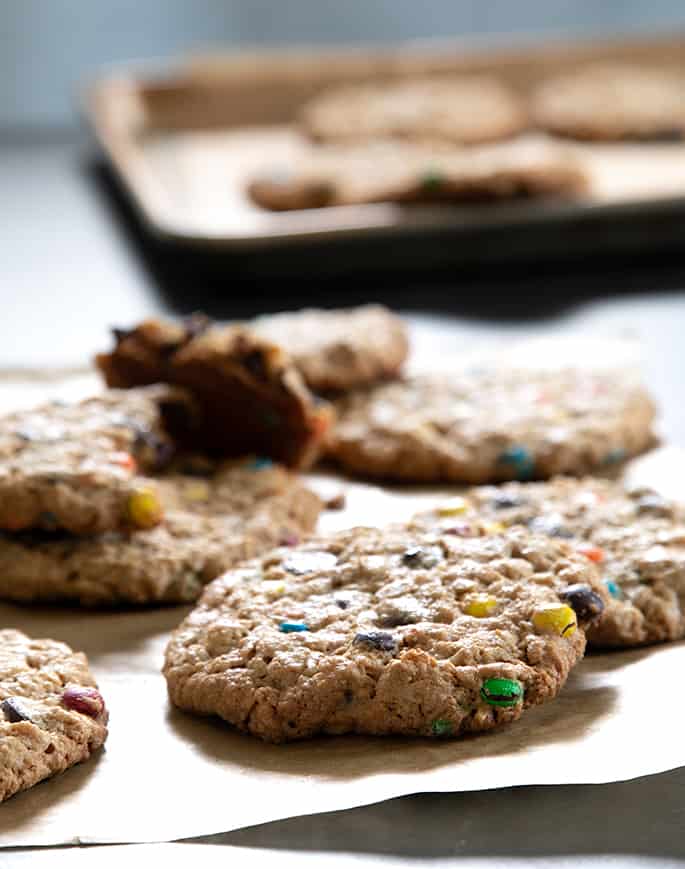

Micelle says
I made them & I thought they were dry but I think I did something wrong. My husband loved them & ended up eating them all. I am going to make the again & I will see what went wrong. Oh I know I gad ran out of brown sugar. I may not creamed it enough. I Will let you know how they turn out. I love your cookbook too.
K.D. says
These cookies are so good I’m taking the time to leave my very first internet recipe review. My kid suggested monster cookies for holiday baking and fortunately you had a recipe (we have a celiac in the house and use your recipes extensively). Incredible! We have made so many batches in the past few weeks I have the recipe memorized – never in my life have I made one recipe so often in such a short time frame. It’s pretty much expected that there will be some ready to eat at all times. With oatmeal and peanut butter you can squint and it even turns into a breakfast food. We left the m&m’s out and didn’t increase the chocolate chips and they were just perfect sweetness for us.
Nicole Hunn says
Hahaha it’s breakfast food if you say it is, K.D.! I’m honored to be your first internet review. I can relate. I don’t leave them myself, even when I know I should! Thank you for sharing your experience. :)
Cathy says
Made these for a large family gathering. I got RAVE reviews from everyone!! Thanks so much for all the tips! Definitely a keeper!
Kathleen says
I made this yesterday and both my picky eaters loved them. They were quite good and it was an easy recipe.
Nicole Hunn says
So glad, Kathleen! Thanks for sharing your good experience. Sympathy for having 2 picky eaters, btw. I’ve been there and it’s not easy!
Michele says
Is it possible to use All Purpose GF flour in this recipe rather than oat flour?
Nicole Hunn says
No, Michele, you can’t. They are not at all interchangeable. If you’d prefer to make a gf oatmeal cookie, just use that recipe on the blog. I also have a recipe for gf peanut butter oatmeal cookies. It’s always best to make a recipe as written, but if you want a different recipe, just use the search function because I bet I already have it developed as you like!
Alene says
Bless you! No rice flour! Since my daughter is grown and out of the house, I will have to eat them all myself, while my husband moans that I need to stop baking. :-) Thank you.
Nicole Hunn says
Haha, stop baking? No no no, Alene. :)
Jackie Hannahs says
I wonder if Rosalind doesn’t realize you can now buy GF oats. I’ve had Celiac for 31 years and was really nervous about trying GF oats when they became available because I am very sick for 30 days when I get glutened. But good news…….I can eat GF oats with no problems!! Do you think we could substitute another type of flour for the oat flour? I don’t have a good blender to make the oat flour. Thanks!
Nicole Hunn says
You could try the oat flour replacement I mention, Jackie, quinoa flakes.
Robyn says
These are fantastic!! Both of us are celiac and neither of us has a problem with certified gf oats.
Thanks so much for the tip on making your own oat flour.
Nicole Hunn says
My pleasure, Robyn! I see no need to buy oat flour. :)
Denise Zavala says
How should you store these, and do they stay fresh/chewy for a couple days?
Nicole Hunn says
They’ll keep fresh for at least a few days in a sealed container at room temperature, Denise, but I always store extra cookies in a freezer-safe bag in the freezer since they’ll keep for a long time like that. Freezer burn is a result of trapping air in the container, so be sure to squeeze out as much air as possible.
Diane Braga says
Nicole these cookies are amazing ! Thank you for sharing your tips. Easy to make in no time at all and came out great the very first try.
My husband and grandaughter love them !!
Nicole Hunn says
So glad, Diane!
Jessica says
These will be PERFECT for my Celiac son and bake sale at work! Off to the kitchen I go! I appreciate you and your dedication to the cause.
Barb says
Most celiacs can eat oats once disease is controlled. My dietician says it is healthiest for non sensitive celiacs to eat oats than not to eat oats as GF diets tend to be low fiber. Oatmeal can also lower lipid levels. As a physician who is also Celiac I trust my dietician completely as her goal is my good health,
Many M and Ms in Canada are GF although “special occasion “ones may not be. In Canada if it has a contains or may contain statement that doesn’t list wheat or gluten it is gluten free. To make this claim the food ingredients must be reliably traced back to its origins. Luckily Canada, Australia and New Zealand are very progressive with food labeling laws.
There are too many gluten and Celiac misconceptions out there so let’s not add to them.
Nicole Hunn says
Thank for your comment, Barb, and the information about M&Ms in Canada.
Stephanie Kast says
Would I be able to freeze the dough before cooking?
Nicole Hunn says
I haven’t tried that specifically, Stephanie, but I generally have great success freezing cookie dough. Just portion and shape it, then freeze it on a baking sheet. Pile it into a freezer safe bag and return to the freezer. Before you’re ready to bake, let the dough thaw to room temperature. If you bake it from frozen, it won’t spread enough.
Betty Baxter says
These look so good but I need sugar free and gluten free. Do you have any recipes like this?
Thank you,
Betty
Nicole Hunn says
You can try using your favorite alternative sugar replacements, Betty, but I’m afraid I don’t have recipes that are specifically sugar-free. Sorry!
Jeanette says
M&M’s in Canada other than pretzel ones are gf. They do recommend always checking the label of course. Great recipe!
Nicole Hunn says
Great to know, Jeanette! Thanks for sharing that info.
Karen says
Most oatmeal including the namebrand is not gluten free so the company told me so make sure
it’s gluten free if you are going for gluten free. I’m wondering about subbing almond flour??
Nicole Hunn says
Yes, Karen, if you are gluten free, your oats should be certified gluten free. Please see a full discussion here. You cannot use almond flour in place of oats. Please see the “ingredients and substitutions” section of the post for information on substitutions.
Rosalind Frizzell says
I read the title of your cookie Nicole, as it specifically says Gluten Free. I have Celiacs and am weary of any recipe that includes Oats. But after reading your comments, suggestions and recipe I am doubtful and too afraid that this recipe would make me ill and send me to the hospital. Too often the words Gluten Free are casually used in a title and then after further reading, I discover the gluten-free terminology isn’t taken seriously. True gluten free does not include Oats. For those without Gluten issues, your recipe sounds like a good chewy & tasty cookie. Best wishes to you and your future recipes.
Nicole Hunn says
Rosalind, if this recipe isn’t for you, then, of course, feel free to pass it on by. You are ultimately responsible for your own health. But I’ve never used the term “gluten free” casually or lightly, having a celiac son and writing a gluten free blog since 2009. I find your statements about oats to be overbroad and inaccurate.
Gayle says
I made a double batch today, no M&Ms, doubled the chocolate chips. They are outstanding! Thanks for the great recipe!
Nicole Hunn says
Awesome, Gayle! I love that you went all in with the double batch right away. ?
Leann says
Thank you so much for the recipe. I have never made Monster cookies, these were quick and easy! I did have to make 1 substitution because I am not sure Mini M&Ms are GF in Canada. I used Mini Reeses pieces and loved them in there. I am not claiming any improvements, just thought other Canadians would be interested too.
Nicole Hunn says
That’s definitely useful information, Leann! And it sounds like a great combo. Thanks for the report!
Ireann says
Thank you for making a cookie recipe that is rice flour free!
Nicole Hunn says
You’re welcome, Ireann! If you can’t have rice flour, definitely check out two categories here on the blog: Paleo recipes, and flourless baking.
Sharon Hastings says
I have celiac disease. Always looking for recipes.
Carol says
I appreciate you sharing this recipe and alterations.
My daughter did the gluten-free test with me. So, now I’m looking for recipes I can make and afford.
Your time and understanding spirit are appreciated.
Nicole Hunn says
My pleasure, Carol. Welcome!
Valerie says
Will this recipe work with gluten-free baking flour instead of the oat flour?
Nicole Hunn says
I haven’t tried that, Valerie, but I’m afraid I really don’t recommend it. It sounds like you’re looking for something more like my recipe for thick and chewy gluten free oatmeal cookies.